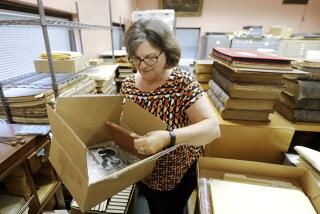Thomas McMahon; Wrote Novels, Textbooks on Scientific History
- Share via
Thomas A. McMahon, a Harvard scientist with an acrobatic intellect whose inventions ranged from a shock-absorbing track for runners to three novels inspired by scientific history, died Sunday in Wellesley, Mass., after abdominal surgery. He was 55.
Like his specialty of biomechanics, a cross between biology and mechanical engineering, McMahon was a hybrid, a scientist-inventor who wrote fiction about scientists and inventors.
He tried to keep his fiction and his scientific pursuits in separate spheres, telling The Times in 1987 that he tried to keep his identity as a novelist “under wraps. . . . It’s an invisible part of me.”
But he believed in the power of science to change lives, an idea that drove his applied research and his novels.
“People turn on lights, use the telephone, and other inventions every day,” McMahon said in an interview several years ago. “But they know little about the inventors or the circumstances that gave birth to these conveniences. I enjoy weaving such elements into fictional stories that inform people and divert them from everyday cares.”
McMahon’s investigations as a scientist revolved around the basic question of physiology: how the body works. He used engineering concepts, including principles of applied physics, to puzzle out the secrets of locomotion in people and other animals.
Some of his discoveries are as whimsical as his novels. In 1996, he and a colleague gained wide notice for figuring out the three-part process that allows certain lizards to walk on water.
A decade earlier, he devised a safer and more effective form of jogging that featured a bowlegged gait made famous by Groucho Marx. He dubbed it “Groucho running” in a paper complete with computer projections that was published by the American Physiological Society.
A more practical outcome of his fascination with locomotion was the indoor track he designed in the 1970s with Harvard colleague Peter Greene. Installed first at Harvard and later at Yale, Madison Square Garden and the Meadowlands arena in New Jersey, the largely plywood indoor track gave runners the sensation of gliding on air and absorbed shock, improving their times by an average of 3% and reducing injuries by half.
McMahon was born in Dayton, Ohio, in 1943. When his parents, both scientists, moved the family to Lexington, Mass., they designed and built their own house.
He was educated at Cornell and MIT and came to Harvard as a postdoctoral research fellow. He was appointed Gordon McKay Professor of Applied Mechanics in 1977.
He wrote dozens of straight science articles and books. His 1984 text, “Muscles, Reflexes and Locomotion,” is considered a classic in the field.
Yet fiction, he said, was a bigger challenge and ultimately the most satisfying because it could “transport someone away from their own troubles for a while. I think that’s really the best thing a person can do.”
McMahon peopled his novels with inventors and tinkerers who were actual historical figures, such as Mourly Vold, the protagonist of his third novel, “Loving Little Egypt,” published by Viking in 1987.
Vold was a young colleague of Sigmund Freud. In McMahon’s tale, he was transformed into an electronics prodigy who tapped into the telephone system to create an underground network for the blind. Other characters are William Randolph Hearst, Helen Keller and Alexander Graham Bell.
Critic Richard Eder wrote in The Times that while McMahon’s plotting was awkward, the story exploring the spirit, mind and aesthetics of invention was “stimulating and bold.” McMahon won the Rosenthal Foundation Award of the American Academy of Arts and Letters for the book.
In “McKay’s Bees,” published in 1979, he took the name of his Harvard benefactor, Gordon McKay, and turned him into a 19th century utopian who wants to create a perfect society based on the principles of beekeeping.
McMahon is survived by his wife, Carol Ehlers McMahon, of Wellesley; a son, James, of Atlanta; a daughter, Elizabeth, of Portland, Me.,; sisters Jean Hunez, of Somerville, Mass., and Nancy Swanborn, of Duxbury, Mass.; and a granddaughter.
More to Read
Sign up for our Book Club newsletter
Get the latest news, events and more from the Los Angeles Times Book Club, and help us get L.A. reading and talking.
You may occasionally receive promotional content from the Los Angeles Times.











